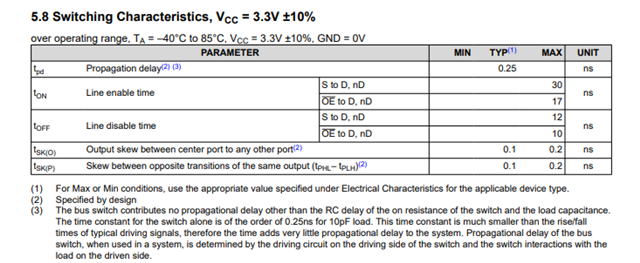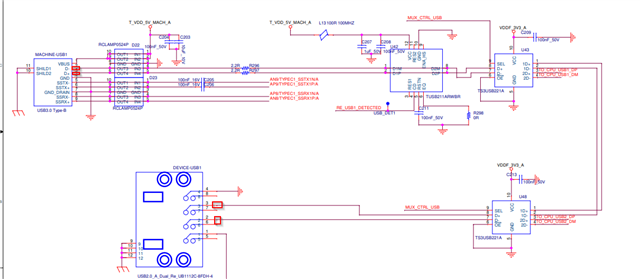Tool/software:
Hi TI team,
I’m using two TS3USB221A chips to build a USB MUX/“small loop” circuit.
Goal / intended behavior
-
When MUX_CTRL_USB = High: both USB ports (PC_USB and DEVICE_USB) should connect to the CPU (RK3588).
-
When MUX_CTRL_USB = Low: the two external USB ports should be shorted together through the two TS3USB221A devices, acting like a simple USB repeater/bridge (PC side
DEVICE side), bypassing the CPU.
Actual result
-
When MUX_CTRL_USB = High (ports → CPU): both ports work normally.
-
When MUX_CTRL_USB = Low (repeater mode): the PC connected to PC_USB cannot enumerate the mouse/keyboard connected to DEVICE_USB. The PC shows no new device.
Design summary
-
2 × TS3USB221A (high-speed USB 2.0 analog switch), each handling D+ / D−.
-
CPU side: RK3588 USB OTG (high-speed capable).
-
External ports:
-
PC_USB → connects to a host PC.
-
DEVICE_USB → connects to a USB device (mouse/keyboard).
-
-
VBUS on each port is routed (5 V present from the PC on PC_USB; 5 V supplied to DEVICE_USB when needed).
-
ESD protection on the connectors; 22 Ω series resistors near the controller; controlled impedance routing for D+/D−.
Symptoms / observations
-
With fast switching to repeater mode, the host PC does not detect any low-speed/full-speed device.
-
If I connect the device directly to the PC (no repeater), it enumerates normally.
Questions
-
Is it valid to “short” two USB connectors through TS3USB221A (i.e., use the switches to directly connect D+ and D− of a host port to a device port), or does USB require an active repeater/hub/PHY for this use case?
-
For USB role detection (DP/DM pull-ups/pull-downs & VBUS presence), do I need extra components or timing control when switching the path with TS3USB221A?
-
Do I need to gate or delay VBUS or the DP 1.5 kΩ pull-up so that the host can re-detect attach?
-
-
Are there recommended application notes for using TS3USB221A in host
device bridging scenarios (not only host/device
CPU MUX)?
-
Do I need dead time between disconnecting from CPU and making the PC
Device path, to avoid partial connects?
-
Any speed limitations (LS/FS/HS) or signal integrity constraints when cascading two TS3USB221A devices back-to-back like this?
-
Would TI recommend a different device (e.g., USB hub, redriver, or dedicated OTG switch) to implement a reliable “PC
USB device” pass-through?
Attachments (to be added)
-
Schematic PDF: TS3USB221A_MUX_Snippet.pdf
Thanks a lot for any guidance on whether my approach is valid and what changes are needed (pull-ups/pull-downs, VBUS control, timing, or a different part).
Best regards,
Wang



